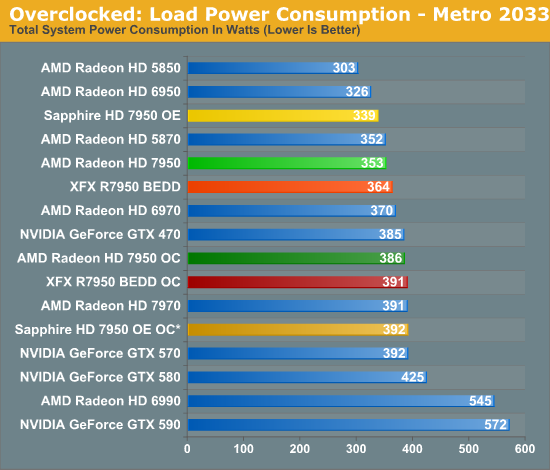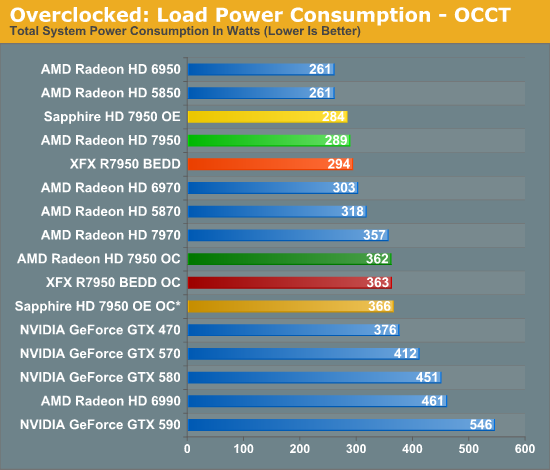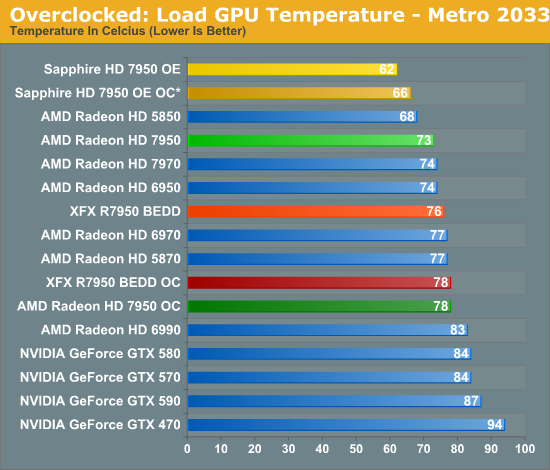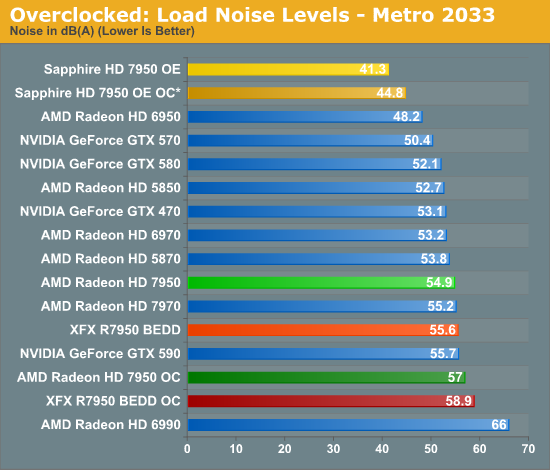AMD Radeon HD 7950 Review Feat. Sapphire & XFX: Sewing Up The High-End Market
by Ryan Smith on January 31, 2012 9:02 AM ESTOverclocking: Power, Temp, & Noise
In their marketing materials AMD is heavily pushing overclocking, and they have good reason to. With the 7970 we’ve established that Tahiti has quite a bit of overclocking headroom, and as the 7950 is clocked lower by default this opens up that headroom even further. Realistically AMD’s binning process means that the best clocking Tahiti GPUs are going to be allocated to the 7970 unless they have failed shaders, but even with that there’s quite a bit of potential on paper.
As with overclocking the 7970, our goal overclocking the 7950 is to see how much you can get for free; that is without any voltage adjustments. AMD’s reference PCBs are not particularly overbuilt for overclocking—cards like that will come later—so sticking to the reference voltage is the safest option, not to mention the easiest. With the 7970 we were able to get 200MHz (22%) overclocks without any voltage adjustment, and we’re hoping for the same out of the 7950.
With that said, we quickly ran into a wall on one card: the Sapphire 7950. Sapphire’s low VID of 0.993v may be great for temperature and noise at stock, but it’s not doing overclocking any favors. We only hit 950MHz at that voltage. As the Sapphire was the odd man out—every other card was at 1.093v—we did end up overvolting the Sapphire to 1.093v to see what it was capable of when put on similar footing as the rest of our cards.
After bringing up the voltage of our Sapphire card, all of our 7950s ended up overclocking to very similar levels. Our Sapphire and AMD cards topped out at 1025MHz core, a 225MHz (28%) overclock over a stock 7950 and a 125MHz (14%) overclock over the Sapphire’s factory overclock, while our XFX card reached 1050MHz, a 150MHz (17%) overclock beyond XFX’s factory overclock. Meanwhile the memory clocks on all of our cards topped out at 5.8GHz, beyond which we’d start seeing performance regressions from error correction on the memory bus.
| Radeon HD 7950 Overclocking | |||||
| AMD Radeon HD 7950 | Sapphire HD 7950 Overclock Edition | XFX R7950 BEDD | |||
| Shipping Core Clock | 800MHz | 900MHz | 900MHz | ||
| Shipping Memory Clock | 5GHz | 5GHz | 5.5GHz | ||
| Shipping Voltage | 1.093v | 0.993v | 1.093v | ||
| Overclock Core Clock | 1025MHz | 1025MHz | 1050MHz | ||
| Overclock Memory Clock | 5.8GHz | 5.8GHz | 5.8GHz | ||
| Overclock Voltage | 1.093v | 1.093v | 1.093v | ||
As you can imagine, with such similar overclocks, gaming performance on all 4 cards ended up being very similar. So we’ll get to gaming performance in a minute, while we’ll start with power, temperature, & noise.


Even though we’re not increasing the voltage on our AMD and XFX cards, merely overclocking them and raising the PowerTune limit to avoid throttling does drive the power consumption up. As is typical with heavily overclocked cards, overclocking quickly drives up power consumption and the 7950s are no exception. After overclocking power consumption is almost identical to the stock 7970, so while you can get 7970 performance you still need to pay the price with 7970 power consumption. Meanwhile it’s interesting to note that even with the extra 0.1v we’ve given the Sapphire card its final power consumption is only ever so slightly higher than the other 7950s, proving that voltage is the great equalizer in this case.


With the increase in power comes an increase in temperatures. The Sapphire card still does very well here staying in the low 70s even under OCCT, while the reference and XFX cards hit the high 70s under Metro and mid 80s under OCCT. As we’ve yet to really ascertain what the thermal limits are for Tahiti, it’s not clear whether there’s too much thermal headroom left for the GPU, particularly under OCCT.


Last but not least we have load noise. The Sapphire card is once more a stellar performer, and we still can’t get it above 50dB even with OCCT. Unfortunately the XFX 7950 BEDD has its biggest fallout yet—it may be able to overclock well, but at 64dB under OCCT the performance isn’t going to be worth the immense amount of noise it creates to move enough air to keep the GPU cool.










259 Comments
View All Comments
Ryan Smith - Tuesday, January 31, 2012 - link
Correct. That's BIOS 015.013.000.010.000705Ryan Smith - Tuesday, January 31, 2012 - link
I should add that this is also the build number of the BIOS on Sapphire's card.AnandThenMan - Tuesday, January 31, 2012 - link
Thanks for the info, appreciated.Sttm - Tuesday, January 31, 2012 - link
There is 0 chance these retarded prices will remain past Nvidia's next gen launch. At that point the 7950 will drop below $300 to be competitive. So if you pay $450 now, you are a chump.mdlam - Tuesday, January 31, 2012 - link
NO....maybe its because you just want the best card. just like all the other "chumps" were paying 500 for a gtx580 or still are, which is a completely disproportionately unfavorable price/performance ratio compared to the 560ti/6950 unlocked.rronald1 - Tuesday, January 31, 2012 - link
I was hoping for $300-350 price tag for 7950.Right now it´s much better to get 2x second hand 6970 running in crossfire, you will get better performances than even 7970 or even 6990.
But we all know the price will drops like stones once Kepler hits the market.
mdlam - Tuesday, January 31, 2012 - link
Only if Kepler isn't a total fail like FermiEugene86 - Tuesday, January 31, 2012 - link
Except Fermi wasn't a fail...artk2219 - Wednesday, February 1, 2012 - link
The original Fermi could most definitely count as a fail, hot loud, power hungry, big, expensive for only 20% more power than a 5870, and LATE, it was fun to watch :). It wasn't until the 460 and the release of the 500 series that Nvidia got that mess worked out.Veroxious - Tuesday, January 31, 2012 - link
While the performance is impressive, the pricing is just ridiculous and leaves a bittter taste in the mouth. One could get similar performance from 2 x 6850 /2 x gtx460's for $320-360.For my next upgrade I was looking for slightly more horsepower than a single gtx580 combined with Ivy bridge. Ofcourse 1st prize for me is a single powerful gpu as opposed to sli/crossfire but at $450 for a reference card it's just pointless. We'll see what happens with Kepler but it seems AMD is setting a recurring trend of increased base cost for every architectural generation which means the costs just keep escalating. What was once a small caliber hole in my pocket seems to have become a 12-gauge crater. Arrrghhhh.........